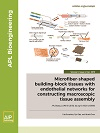
Advanced Biology
Scope & Guideline
Connecting Researchers to Shape the Future of Biology
Introduction
Aims and Scopes
- Synthetic Biology and Bioengineering:
Research focusing on the design and construction of new biological parts, devices, and systems, as well as the re-design of existing, natural biological systems for useful purposes. - Cellular and Molecular Biology:
Investigations into cellular mechanisms, molecular interactions, and the impact of genetic and environmental factors on cellular behavior and health. - Cancer Biology and Therapeutics:
Studies that explore the mechanisms of cancer development, progression, and metastasis, alongside novel therapeutic strategies including immunotherapy and targeted treatments. - Regenerative Medicine and Tissue Engineering:
Research aimed at developing methods to repair or replace damaged tissues and organs, utilizing stem cells, biomaterials, and 3D bioprinting techniques. - Neuroscience and Neurobiology:
Exploration of neuronal mechanisms, neurodegenerative diseases, and the role of neural cells in health and disease, including interactions between the nervous system and tumors. - Microphysiological Systems and Organ-on-Chip Technologies:
Development and application of in vitro models that mimic human physiology for drug testing, disease modeling, and understanding complex biological interactions. - Metabolism and Aging:
Research that investigates metabolic pathways, their alterations with aging, and the implications for healthspan and longevity. - Immune System Dynamics:
Studies focusing on the immune response, modulation of immune cells, and the role of the immune system in cancer and other diseases.
Trending and Emerging
- Artificial Intelligence and Machine Learning in Biology:
An increasing number of studies are leveraging AI and machine learning techniques to analyze complex biological data, predict outcomes, and optimize experimental designs. - Microphysiological Systems and Personalized Medicine:
Research focusing on the development of microphysiological systems for personalized medicine is on the rise, providing insights into human-specific responses to drugs and diseases. - Biomaterials and 3D Printing in Tissue Engineering:
There is a growing trend in the use of advanced biomaterials and 3D printing technologies to create complex tissue structures for regenerative medicine applications. - Interdisciplinary Approaches to Aging Research:
Studies integrating biology, technology, and social sciences to address challenges related to aging are gaining prominence, reflecting a holistic view of healthspan and longevity. - Gut Microbiome and Its Role in Health:
Research exploring the interactions between the gut microbiome and various health conditions is increasingly featured, highlighting its relevance in metabolic, immune, and neurological health. - Cancer Immunotherapy Innovations:
The development of novel cancer immunotherapeutic strategies, including the use of CAR-T cells and checkpoint inhibitors, is a rapidly growing area of focus. - Environmental and Stress Responses in Biology:
Emerging studies are investigating how environmental factors, including climate change, affect biological systems and influence health, reflecting a trend towards ecological awareness in biology.
Declining or Waning
- Traditional Pharmacology Approaches:
There has been a noticeable decrease in studies relying solely on conventional pharmacological methods, with a shift toward more integrative and systems biology approaches. - Single-Cell Analysis in Non-Cancer Research:
Although single-cell technologies remain popular, their application in non-cancer research topics has seen a reduction, likely due to the overwhelming interest in cancer-specific applications. - Basic Descriptive Studies without Experimental Innovation:
Papers that focus primarily on basic descriptive biology without introducing novel experimental methodologies or technologies are becoming less common, reflecting a preference for innovative research. - Animal Models for Drug Testing:
The reliance on traditional animal models for drug testing is gradually declining as more complex in vitro models, like organ-on-chip systems, gain traction for their relevance to human biology. - General Reviews without New Insights:
The journal is moving away from general review articles that do not provide new insights or perspectives, favoring those that offer innovative frameworks or critical analysis.
Similar Journals

Life Science Alliance
Unlocking Potential in Life Science Research.Life Science Alliance, published by LIFE SCIENCE ALLIANCE LLC, is a premier open access journal that has been making significant contributions to the fields of Biochemistry, Genetics and Molecular Biology, Ecology, Health, Toxicology and Mutagenesis, and Plant Science since its inception in 2018. With an impressive ranking in Scopus, including Q1 quartile positions and high percentiles in relevant categories, this journal is a vital resource for researchers, professionals, and students alike who seek to advance knowledge and innovation in life sciences. The journal operates on an open access model, ensuring that research findings are freely available to the global scientific community, thereby enhancing the visibility and impact of published work. With a commitment to fostering collaboration and disseminating high-quality research, Life Science Alliance serves as an essential platform for the promotion and exchange of scientific knowledge, aiming to bridge gaps and stimulate discussions across multiple disciplines.

ACTA HISTOCHEMICA
Illuminating Cell Structures Through Rigorous Histochemical StudyACTA HISTOCHEMICA, a prestigious journal published by Elsevier GmbH, is dedicated to advancing the field of histochemistry and its applications within cell biology and medicine. With an ISSN of 0065-1281 and an E-ISSN of 1618-0372, the journal provides a critical platform for the dissemination of high-quality research findings and reviews, integral for both emerging and established scholars. Since its inception in 1954 and continuing through to 2024, ACTA HISTOCHEMICA has maintained a strong commitment to publishing significant advancements in histology and cell biology, as evidenced by its categorization in Q3 for Cell Biology and Histology, as well as Q2 in miscellaneous medicine for the year 2023. The journal ranks favorably in Scopus, holding the 27th rank in Histology and a 200th rank in Cell Biology, highlighting its importance to the academic community. With its headquarters in Munich, Germany, ACTA HISTOCHEMICA continues to attract contributions from global researchers, fostering an international dialogue essential for the growth of knowledge in histochemistry and related disciplines.

FASEB BioAdvances
Unlocking the Secrets of Life SciencesFASEB BioAdvances, published by WILEY, is an esteemed open-access journal dedicated to advancing the fields of biochemistry, molecular biology, and physiology. Since its inception in 2019, the journal has rapidly established a significant presence within the academic community, boasting an impressive impact factor reflective of its Q2 and Q3 standings across various categories, including Biochemistry, Genetics and Molecular Biology, Cancer Research, Molecular Medicine, and Physiology. The journal aims to disseminate high-quality research and innovative findings to enhance the understanding of biological processes, making it a vital resource for researchers, professionals, and students alike. With its commitment to open access, FASEB BioAdvances ensures that groundbreaking research is available to a global audience, facilitating collaboration and exploration in these rapidly evolving scientific domains.

PROTEIN AND PEPTIDE LETTERS
Illuminating the dynamic landscape of protein and peptide studies.PROTEIN AND PEPTIDE LETTERS is a prominent peer-reviewed journal published by Bentham Science Publishers Ltd, specializing in the dynamic fields of biochemistry and structural biology. With an ISSN of 0929-8665 and a corresponding E-ISSN of 1875-5305, the journal has been a pivotal platform for researchers since its inception in 1994. Spanning various aspects of protein and peptide research, it aims to disseminate groundbreaking findings that enhance our understanding of molecular mechanisms and therapeutic applications. Although categorized in the Q3 quartile for biochemistry and medicine, and Q4 in structural biology within the 2023 metrics, it remains a valuable resource in the academic arena, offering insight into the latest research and advancements. As the journal converges towards its 2024 milestone, it continues to reflect the evolving landscape of molecular research. While it currently does not offer open access, the accessibility to its impactful content is essential for students, professionals, and researchers invested in these critical scientific disciplines.

Cell and Bioscience
Elevating the Standards of Cellular and Bioscience InquiryCell and Bioscience is a prestigious open-access journal published by BMC that has been at the forefront of biochemistry, genetics, and molecular biology since its inception in 2011. With an impressive impact factor, this journal has established itself as a vital resource for researchers and professionals in these rapidly advancing fields, reflecting its high ranking of #29 out of 221 in the Scopus classification and placing it in the 87th percentile. Based in the United Kingdom, Cell and Bioscience aims to foster innovation and dissemination of research findings addressing critical biological questions through rigorous peer-reviewed articles and inter-disciplinary approaches. The journal's open-access model ensures unrestricted access to transformative research, promoting collaboration and knowledge sharing among academics, students, and practitioners worldwide. With a commitment to maintaining excellence in the field, Cell and Bioscience provides an essential platform for those looking to contribute to the evolving landscape of biosciences.

CELLULAR & MOLECULAR BIOLOGY LETTERS
Advancing the Frontiers of Cellular and Molecular ScienceCELLULAR & MOLECULAR BIOLOGY LETTERS, published by BMC, is a premier open-access journal dedicated to disseminating high-quality research in the fields of Biochemistry, Cell Biology, and Molecular Biology. Established in 1996, the journal has emerged as a leader in its domain, boasting an impressive Q1 ranking across three critical categories as of 2023, reflecting its significant impact within the scientific community. With an ISSN of 1425-8153 and an E-ISSN of 1689-1392, it offers accessible research findings to a global audience, having been open access since 2013. Situated in the United Kingdom, at CAMPUS, 4 CRINAN ST, LONDON N1 9XW, the journal continues to serve as a vital resource for researchers, professionals, and students, contributing to advancements in the understanding of cellular and molecular processes. By providing a platform for original research, reviews, and short communications, CELLULAR & MOLECULAR BIOLOGY LETTERS plays a crucial role in fostering dialogue and collaboration within the scientific community.

Regenerative Medicine
Advancing the Frontiers of HealingRegenerative Medicine, published by Taylor & Francis Ltd, is a pivotal journal within the field of biomedical research, focusing on the innovative advances in regenerative and restored functions in human health. With an ISSN of 1746-0751 and an E-ISSN of 1746-076X, this esteemed journal boasts a commendable impact factor within its categories, notably holding the Q2 status in Embryology and Q3 in Biomedical Engineering as of 2023. Covering a broad spectrum of topics from stem cell research to tissue engineering, it serves as a crucial platform for interdisciplinary collaboration among researchers, professionals, and students dedicated to the regeneration of tissues and organs. Given its comprehensive scope from 2006 to 2024, the journal continues to attract high-quality manuscripts that advance the frontiers of knowledge in regenerative medicine. Researchers and practitioners alike are encouraged to engage with the latest findings and methodologies disseminated in this vital publication.

APL Bioengineering
Connecting Minds, Elevating Bioengineering InnovationsAPL Bioengineering is a premier open-access journal published by AIP Publishing, dedicated to advancing the field of bioengineering and its interdisciplinary applications. Established in 2017, this journal serves as a vital platform for researchers, professionals, and students interested in the critical intersections of bioengineering, biomaterials, biomedical engineering, and biophysics. With an impressive impact factor and consistent rankings in the Q1 category across multiple domains, including biochemistry and materials science, APL Bioengineering has positioned itself among the top journals in its field. The journal aims to publish innovative original research, comprehensive reviews, and insightful case studies that further the understanding and application of bioengineering principles. Since its inception, APL Bioengineering has fostered a community of thought leaders, providing open access to ensure broad dissemination of knowledge and advancements that underpin the future of biomedical innovation.

CELLULAR AND MOLECULAR NEUROBIOLOGY
Unlocking the Secrets of Cellular Mechanisms.CELLULAR AND MOLECULAR NEUROBIOLOGY, published by SPRINGER/PLENUM PUBLISHERS, stands as a significant contributor to the fields of cell biology and neuroscience, holding a distinguished position in the academic community with an impact factor that places it in the Q2 category for both Cell Biology and Cellular and Molecular Neuroscience, along with Q1 in Medicine (miscellaneous). Since its inception in 1981, this journal has provided a critical platform for innovative research and thought-provoking reviews, fostering a deeper understanding of complex neurobiological mechanisms. The journal’s rigorous peer-review process ensures the publication of high-quality manuscripts that offer valuable insights into cellular processes and neural functions. With a commitment to advancing knowledge and promoting collaboration among researchers, CELLULAR AND MOLECULAR NEUROBIOLOGY remains an essential resource for professionals and students alike, looking to stay updated on the latest developments in neurobiology.

BIOMEDICAL RESEARCH-TOKYO
Fostering Collaboration in Cutting-edge Biomedical ResearchBIOMEDICAL RESEARCH-TOKYO is an esteemed interdisciplinary journal published by BIOMEDICAL RESEARCH PRESS LTD, dedicated to disseminating pioneering research and advancements in the fields of biochemistry, genetics, and medicine. Since its inception in 1980, the journal has established itself as a reputable source of knowledge, contributing significantly to the global scientific community with its strong emphasis on innovative findings and methodologies. With a consistent presence in the Q3 quartile for both Biochemistry, Genetics and Molecular Biology and Medicine categories as of 2023, it continues to attract a diverse range of research articles. While the journal does not operate as an open access platform, it remains an essential resource for researchers, professionals, and students seeking to further their understanding of biomedical sciences. Located in Sapporo, Japan, this journal fosters collaboration and knowledge sharing among the international biomedical research community, engaging readers through its compelling studies that span from 1980 to 2024.